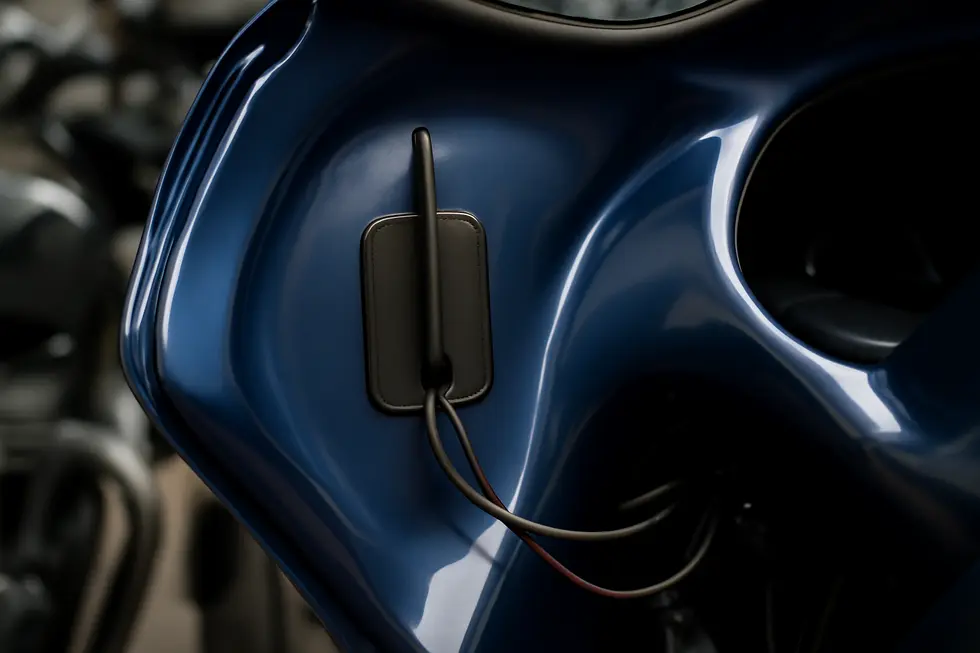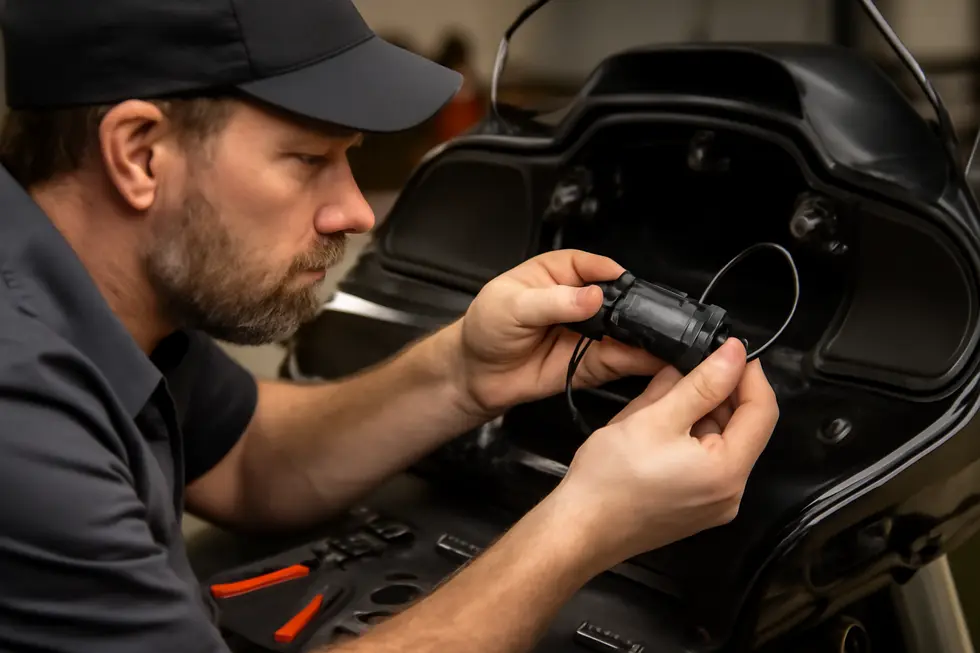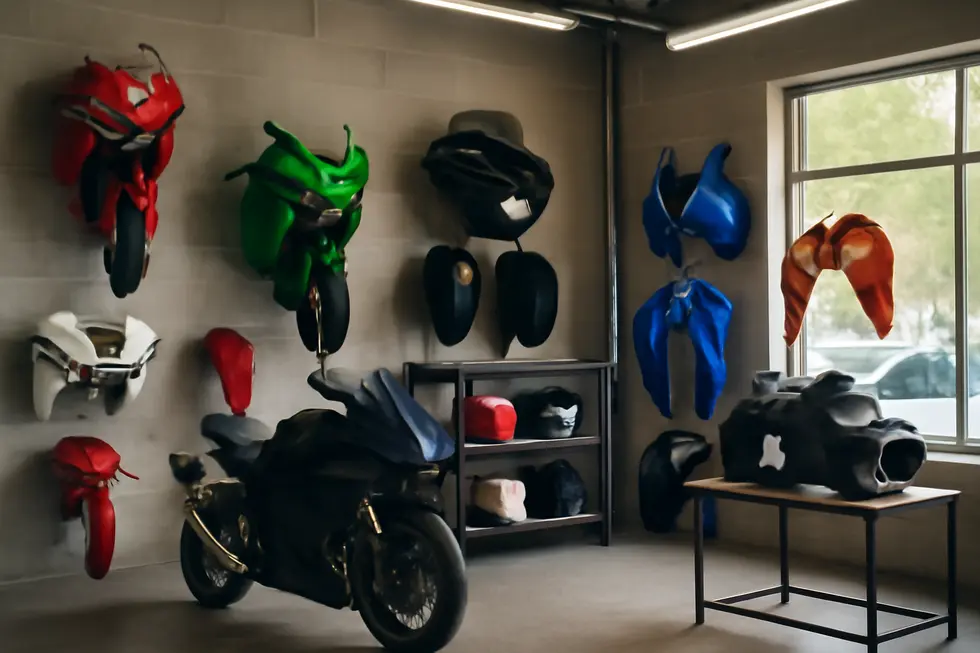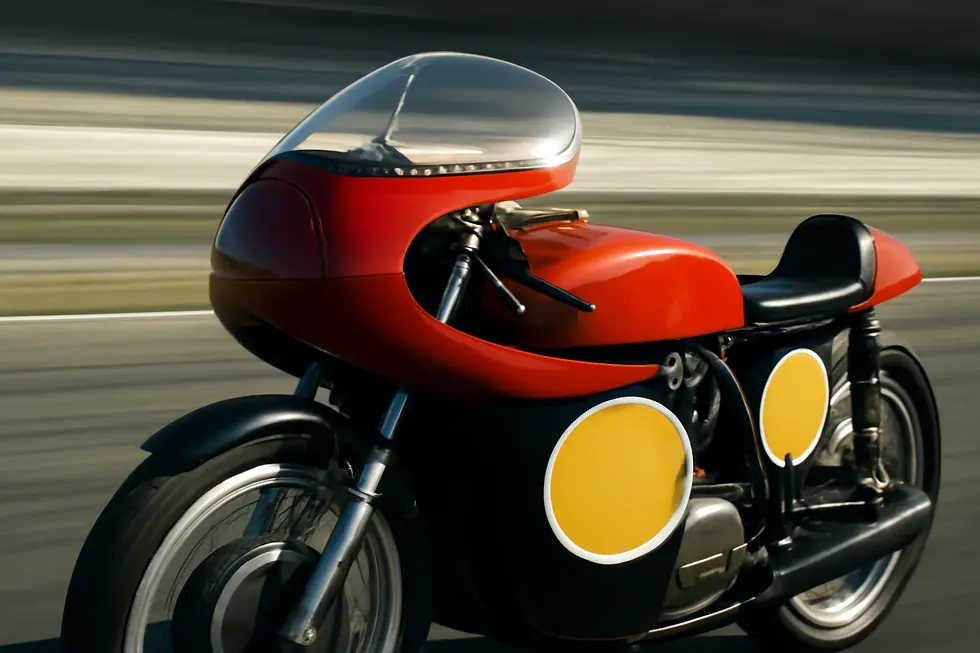Enhancing Motorcycle Performance: The Strategic Role of Fairing Antennas
October 4, 2025 | by summitfairings

Introduction
Motorcycle fairing antennas have emerged as crucial components that seamlessly combine technology with design to optimize both communication and aesthetic appeal. For business owners in the motorcycle industry, understanding fairing antenna design, performance, and aftermarket possibilities offers a competitive advantage. This knowledge enables smarter inventory decisions, improved customer service, and strategic partnerships with manufacturers and suppliers. The first chapter explores the intricate design and integration of these antennas within the fairing, emphasizing how they preserve the motorcycle’s aerodynamic and visual integrity. The second chapter centers on their functionality and performance, underlining how reliable signal reception enhances rider safety and entertainment. Finally, the third chapter covers the spectrum of aftermarket solutions and installations that allow business owners to provide versatile, high-quality options tailored to various motorcycle brands and rider preferences.
Tables of Contents
Chapter 1: Design and Integration of Motorcycle Fairing Antennas
- Harmonizing Aerodynamics and Structural Integrity in Motorcycle Fairing Antenna Design
- Advancing Connectivity: Material, Antenna, and Multimedia Synergies within Motorcycle Fairings
Chapter 2: Functionality and Performance of Motorcycle Fairing Antennas
- Engineering Excellence: How Motorcycle Fairing Antennas Deliver Optimal Performance and Seamless Functionality
- Mastering Installation and Optimization for Peak Performance of Motorcycle Fairing Antennas
Chapter 3: Aftermarket Solutions and Installations for Motorcycle Fairing Antennas
- Innovations Shaping Aftermarket Motorcycle Fairing Antenna Designs and Installations
- Practical Installation Approaches, Cost Factors, and Trusted Service Providers for Aftermarket Motorcycle Fairing Antennas
Chapter 1: Design and Integration of Motorcycle Fairing Antennas

1. Harmonizing Aerodynamics and Structural Integrity in Motorcycle Fairing Antenna Design
Achieving an optimal balance between aerodynamics and structural integrity is paramount when designing motorcycle fairing antennas. These antennas must integrate seamlessly into the fairing’s streamlined form without degrading the motorcycle’s airflow dynamics or imposing mechanical weaknesses.
Motorcycle fairings are precision-engineered to reduce drag and minimize turbulence around both the rider and the machine. Embedding antennas into this aerodynamic shell demands careful attention to shape and placement. Antennas flush-mounted within the fairing surface preserve smooth airflow and prevent external protrusions that would otherwise create aerodynamic drag or disruptive eddies. Positioning antennas in areas where airflow remains relatively stable—typically near the upper or rear sections of the fairing—supports consistent signal reception while minimizing wind resistance and buffeting effects that can affect rider comfort.
Beyond aerodynamics, the structural considerations are equally critical. Fairings are predominantly manufactured from advanced composite materials such as fiberglass or carbon fiber reinforced polymers (CFRP). These materials combine lightness with exceptional strength and offer inherent radio-frequency transparency, which is essential for unobstructed antenna performance. The fairing must be carefully molded to accommodate the antenna while preserving the fairing’s rigidity and impact resistance.
Mounting systems for fairing antennas navigate rugged riding conditions characterized by intense vibrations, shock loads, and exposure to moisture and temperature fluctuations. To safeguard antenna components and maintain reliable signal quality, vibration damping becomes an integral part of the design. Incorporating vibration isolators or elastomeric mounts helps absorb mechanical stresses and prolongs antenna longevity without compromising aerodynamic shape or fairing integrity.
Importantly, the fusion of functional engineering and aesthetics shapes the overall outcome. A fairing antenna that disrupts the motorcycle’s visual flow or adds unsightly hardware detracts from the bike’s iconic styling. Designers employ concealed installation techniques, hiding antennas within the fairing’s contours where they remain invisible to the eye yet fully operative. This subtle integration enhances the riding experience by delivering dependable connectivity without sacrificing the motorcycle’s sleek, aggressive appearance.
The design approach parallels principles used in related fields like helmet antenna integration, where aerodynamic form and signal performance coalesce. In both cases, the challenge lies in harmonizing physical and electromagnetic demands within tight spatial constraints, all while ensuring rider comfort and durability.
The long-term success of motorcycle fairing antenna systems relies on leveraging advanced composite materials and sophisticated mounting strategies to ensure minimal aerodynamic impact, maximal structural resilience, and efficient radio-frequency transmission. This integration fosters a riding environment where communication technology complements rather than competes with the motorcycle’s aerodynamic and structural design.
For those seeking further insight into the significance of fairing designs that optimize both performance and style, exploring expert resources on motorcycle fairings and their aerodynamic properties can deepen understanding and appreciation of this specialized accessory: discover unmatched choices in motorcycle fairings at Summit Fairings.
2. Advancing Connectivity: Material, Antenna, and Multimedia Synergies within Motorcycle Fairings
The evolution of motorcycle fairing antennas reflects a dynamic interplay between advanced materials, innovative antenna architectures, and modern multimedia integration. This synergy has transformed these once-simple components into sophisticated systems that elevate both communication performance and rider experience.
At the core of this advancement lies the use of cutting-edge composite materials. Carbon fiber reinforced polymers and specialized thermoplastic composites are increasingly employed to provide fairings that are not only lightweight but structurally robust. These materials support the embedding of antennas directly within the fairing shell without affecting its integrity or aerodynamic profile. Manufacturing processes such as water-assisted injection molding and tailored blank line technology enhance precision in embedding antennas, allowing them to blend seamlessly into the motorcycle’s design. The result is a fairing assembly that maintains sleekness and durability while discreetly housing essential signal components.
Concurrently, antenna technology has progressed to address the complex communication needs of modern riders. Dual-antenna systems, supported by separate signal processors, offer simultaneous multi-protocol functionality. This allows riders to maintain connections with various devices like intercoms, GPS navigation, and entertainment systems without signal interference. This sophisticated architecture ensures high signal fidelity and robust performance even in demanding environments. By integrating these dual systems unobtrusively within the fairing, motorcycles achieve superior communication capabilities while preserving their iconic streamlined appearance.
Moreover, multimedia integration within motorcycle fairings has become a hallmark of contemporary design. Antenna systems now support wireless modules compatible with popular smartphone connectivity platforms and satellite radio services. Advanced tuners equipped with feed-forward control technologies minimize audio interference, delivering clearer sound and reliable reception. This integration harmonizes the structural and electronic aspects of the fairing, resulting in a unified system where form and function coexist without compromise.
This multidisciplinary approach, combining materials science, antenna engineering, and multimedia technology, defines the modern motorcycle fairing antenna landscape. These advances do not simply improve hardware performance but enhance the rider’s interactive experience by ensuring consistent connectivity and media accessibility. The continuous evolution of these systems reflects ongoing efforts to balance aesthetic subtlety with technological complexity in compact, aerodynamic motorcycle assemblies.
For more insights on the innovative options and design approaches in modern motorcycle fairings, explore the rich variety available at Summit Fairings, where functionality and style converge seamlessly.
Chapter 2: Functionality and Performance of Motorcycle Fairing Antennas

1. Engineering Excellence: How Motorcycle Fairing Antennas Deliver Optimal Performance and Seamless Functionality
Motorcycle fairing antennas stand as a remarkable blend of engineering precision and design sophistication, crafted to uphold both signal integrity and aerodynamic finesse. Their foremost technological advantage lies in the internal concealment within the fairing structure, a strategy developed to minimize wind resistance and maintain the motorcycle’s sleek silhouette. Unlike traditional external antennas, which can disrupt airflow and add unwanted bulk, these hidden antennas harness the fairing’s space to create a low-profile yet highly functional component.
By embedding the antenna inside the fairing’s durable, OEM-quality injection-molded plastics, manufacturers ensure a firmly secured unit that resists the severe conditions encountered during rides. This internal placement does more than preserve aesthetics; it shields the antenna from physical wear, wind turbulence, moisture, and vibration — all factors that could degrade performance over time. The result is a resilient system with prolonged longevity and stable reception, crucial for riders who depend on uninterrupted radio or communication signals.
Balancing performance with durability demands meticulous design and materials choice. The antenna elements are constructed to capture AM/FM signals effectively despite being enclosed, employing advanced materials and precise tuning. This technical refinement means riders experience clear reception without having to compromise the motorcycle’s original design or add cumbersome external parts. Additionally, fairing antennas incorporate secure electrical integration, often with plug-and-play capabilities or quick-release mounting systems, facilitating straightforward installation and maintenance while maintaining solid electrical connections.
Functionality extends beyond signal capture. Modern motorcycle fairing antennas are designed with compatibility in mind, seamlessly interfacing with contemporary multimedia systems. This enables riders to enjoy integrated audio experiences, including smartphone connectivity features such as Apple CarPlay and Android Auto. Such integration empowers riders to access navigation, communication, and entertainment safely and easily, all while preserving the factory-like clean appearance of the motorcycle’s cockpit.
This thoughtful fusion of engineering and user-focused design elevates the rider’s experience by ensuring the antenna remains unobtrusive yet highly effective. The aerodynamic advantages of internal mounting reduce drag and noise created by external protrusions, contributing to smoother rides and enhanced fuel efficiency. Moreover, the protection from external elements guarantees consistent signal performance, which is essential for road safety when relying on communication devices during long rides.
The ongoing innovation in materials, mounting techniques, and system compatibility underscores the niche yet critical role motorcycle fairing antennas play. Riders benefit from advanced antenna solutions that do not force a trade-off between style and function. Instead, these antennas harmonize with the motorcycle’s overall design ethos while delivering robust signal performance and ease of use.
For those interested in exploring an extensive range of fairing designs that support such advanced integrations, explore the best motorcycle fairings at Summit Fairings, offering options that blend quality, aesthetics, and functional enhancements.
2. Mastering Installation and Optimization for Peak Performance of Motorcycle Fairing Antennas
The installation and optimization of motorcycle fairing antennas are crucial elements that directly affect their performance and reliability. A well-executed setup balances technical precision with aesthetic integration, ensuring the antenna delivers strong, consistent signal reception without altering the motorcycle’s sleek profile or aerodynamics.
Selecting the ideal mounting location represents the foundation of effective antenna functionality. Fairings present limited internal space often surrounded by metal components and electronic systems, both potential sources of signal interference. Placing the antenna in an area that reduces obstruction—typically within or just behind the fairing but away from heavy metallic parts—ensures better signal propagation. Purpose-designed mounting brackets or plates help secure antennas firmly within these confined spaces, protecting them from vibrations and allowing maintenance access while preserving the motorcycle’s integrated look.
Equally important is the antenna type and size. Options span from compact internal designs to quarter-wave whip antennas, each offering varying gain and frequency coverage. Longer whip antennas or those combined with ground plane enhancements may improve reception range and robustness. However, exceeding spatial or aerodynamic limits may increase wind resistance or create imbalances, necessitating a judicious choice to harmonize performance with riding stability.
The electrical grounding and wiring setup is another critical factor that determines signal clarity and strength. High-grade wiring with secure, vibration-resistant connectors minimizes signal attenuation and electromagnetic interference, especially in the harsh motorcycle environment. Proper grounding within the bike’s electrical system is essential to prevent noise and ensure transmission efficiency.
Fairing materials and shape influence signal transmission subtly but meaningfully. Composite or high-strength steel fairings can partially block or attenuate radio waves, making material choice and antenna placement a strategic decision. Sleek, sculpted fairings designed for aerodynamic flow not only enhance bike stability but can impact optimal antenna location to avoid disruptive signal shadows.
Integration with the motorcycle’s audio and communication systems raises the performance threshold further. Modern systems relying on Bluetooth, FM radio, or even GPS demand antennas positioned and tuned for seamless interaction, maximizing connectivity and sound quality. Concealed antenna designs that merge effortlessly into fairings while maintaining strong system links exemplify this integrated approach.
Beyond functionality, environmental factors such as exposure to rain, UV radiation, and wind require antennas and mounts constructed from durable, corrosion-resistant materials. Secure fastening mechanisms must withstand these conditions without loosening or degrading, ensuring ongoing performance reliability.
Finally, ease of installation and servicing rounds out effective optimization. Mount systems permitting quick-release or tool-free removal of fairing panels simplify troubleshooting and upgrades, reducing labor time and preserving the motorcycle’s finish.
Achieving optimal performance in motorcycle fairing antennas involves harmonizing these factors: choosing the right location and antenna type, ensuring robust electrical connections, respecting fairing design constraints, facilitating system integration, and securing durable, maintainable installations. Such attention to detail guarantees that the antenna performs reliably while preserving the motorcycle’s signature appearance and aerodynamic properties. For riders and technicians alike, mastering these installation and optimization principles defines the difference between standard reception and exceptional communication quality.
For further insights on integrating components with motorcycle fairings, refer to comprehensive resources like Explore the Best Motorcycle Fairings at Summit Fairings.
Chapter 3: Aftermarket Solutions and Installations for Motorcycle Fairing Antennas

1. Innovations Shaping Aftermarket Motorcycle Fairing Antenna Designs and Installations
Advances in aftermarket motorcycle fairing antenna technology focus on blending high performance with seamless integration into the bike’s design, while addressing durability and functionality under demanding conditions. A key breakthrough lies in the development of ultra-lightweight composite materials. For instance, innovative composites enable fairings that weigh less than half their traditional counterparts without compromising strength. These lighter fairings not only reduce overall motorcycle weight but also improve mounting stability for integrated antennas, ensuring reliable signal reception even in high-vibration scenarios. Such materials facilitate complex fairing shapes that accommodate concealed antenna placements, enhancing both aerodynamics and aesthetics.
Complementing material innovations, aftermarket solutions increasingly prioritize compatibility with original equipment manufacturer (OEM) systems. Products now frequently maintain the factory antenna cable connections, allowing riders to install upgraded or hidden antennas without altering or damaging the motorcycle’s wiring harness. This plug-and-play approach preserves the bike’s factory look and minimizes installation complexity. By leveraging OEM mounting hardware and antenna inputs, these systems ensure full functional integration, maintaining radio reception quality while eliminating the need for bulky external antennas or additional brackets.
Connectivity features have also evolved substantially in aftermarket antenna installations. Modern head units often support wireless headset pairings, enabling group ride music sharing and hands-free communication. Integration with smartphone platforms through wireless Apple CarPlay® and Android Auto® further enhances rider experience by providing GPS navigation, music streaming, and calls without cluttering the fairing with extra devices. These advancements demand antennas that deliver consistent, interference-free signals amid increasing electronic complexity. To meet this, manufacturers employ miniaturized, shielded connectors designed to minimize electromagnetic interference, ensuring stable data transmission and audio fidelity.
Riders benefit greatly from the weather-resistant design of aftermarket fairing antennas and components. IPx5-rated enclosures and robust housings protect sensitive electronics from moisture, dust, and temperature extremes. This resilience guarantees long-term reliability even during harsh environments and extended journeys, reinforcing the antenna’s role as an indispensable tool for communication and entertainment on the road.
Sustainability trends are gradually influencing the materials used in fairing and antenna production. The use of bio-based resins and recycled carbon fiber composites is emerging, promising greener manufacturing processes without sacrificing performance. These eco-conscious innovations hint at a future where aftermarket solutions balance durability, functionality, and environmental responsibility.
Together, these developments enable aftermarket motorcycle fairing antenna systems that are lighter, smarter, and more adaptable than ever. For riders looking to enhance their motorcycle’s connectivity discreetly, these innovations deliver elegant solutions that integrate effortlessly and endure the rigors of the open road. To explore premium fairing options that complement such advanced aftermarket antennas, see the extensive choices available at Summit Fairings, a trusted source for quality motorcycle fairings.
2. Practical Installation Approaches, Cost Factors, and Trusted Service Providers for Aftermarket Motorcycle Fairing Antennas
Aftermarket installation of motorcycle fairing antennas is a nuanced process that balances technical precision, aesthetic preservation, and cost-efficiency. Typically, installers begin by routing critical cables—such as antenna extensions, USB connections, and audio inputs—carefully through existing cutouts within the motorcycle’s inner fairing. This approach preserves the integrity of the fairing while reducing exposure of wiring that could compromise the bike’s streamlined appearance. Attaching antenna units often involves securing them with screws or bolts to existing fairing support brackets. In several cases, installation requires removal of components like the ignition switch or portions of the fairing panels to access mounting points safely, allowing for a sturdy, vibration-resistant fit. Well-designed aftermarket antennas frequently feature direct bolt-on mounting options, especially in models tailored for popular motorcycle brands, which significantly simplify installation and reduce the need for custom fitting or fabrication.
Economic considerations significantly influence choices in aftermarket antenna solutions. Higher-quality, OEM-compatible parts often command a premium price but reward buyers with longevity and consistent signal performance. Direct bolt-on designs minimize labor time, translating into lower installation costs when professional service is employed. Many aftermarket kits include all necessary hardware—screws, connectors, and rubber grommets—helping riders avoid additional purchases and streamlining the installation process. Relying on specialized service providers who understand the nuances of motorcycle electronics can further reduce potential troubleshooting and ensure seamless integration. Conversely, opting for cheaper, less compatible parts may result in additional expenses down the line due to poor fitment or signal issues.
Service providers in this market range from specialized motorcycle spare parts dealers to dedicated installation shops focusing on aftermarket accessories. Certain dealers emphasize compatibility with major touring motorcycle brands, offering bespoke antenna mounts and installation kits that align with the distinct designs and mounting points of these models. Regional dealers in key motorcycle hubs provide valuable expertise, often coordinating with trusted installers to ensure professional assembly. Moreover, some aftermarket manufacturers supply detailed manuals and installation accessories targeted at skilled do-it-yourself enthusiasts, allowing experienced riders to perform confident self-installs while preserving the bike’s aesthetic and functional integrity.
Overall, the success of aftermarket motorcycle fairing antenna installations rests on a carefully choreographed balance of correct cable routing, secure and compatible mounting, and the judicious selection of service providers and parts. Riders seeking to enhance communication and entertainment capabilities without undermining their motorcycle’s design will find these considerations essential. For those interested in exploring a broad range of compatible motorcycles and fairings, the resource “Explore the Best Motorcycle Fairings at Summit Fairings” offers valuable insights and options.
Final thoughts
Motorcycle fairing antennas represent a sophisticated intersection of aesthetic design and technical functionality, essential for modern riders and motorcycle businesses alike. Understanding their design and integration clarifies how these components maintain sleek profiles while embedding critical communication technology. Appreciating their performance ensures that businesses can advocate for superior signal reliability, which improves rider safety and entertainment. Moreover, familiarity with aftermarket solutions expands opportunities to serve diverse clientele with tailored upgrades and installations. By embracing the strategic value of fairing antennas, business owners position themselves to capitalize on a niche market that blends innovation with style, ultimately enhancing customer satisfaction and brand reputation.
Ready to elevate your ride? Summit Fairings delivers premium, custom-fit fairings that blend style and durability. Whether you’re chasing speed or turning heads, we’ve got your bike covered. Don’t wait—transform your machine today. Click, customize, and ride with confidence. Your perfect fairing is just a few clicks away. Act now!
About us
undefined
RELATED POSTS
View all



